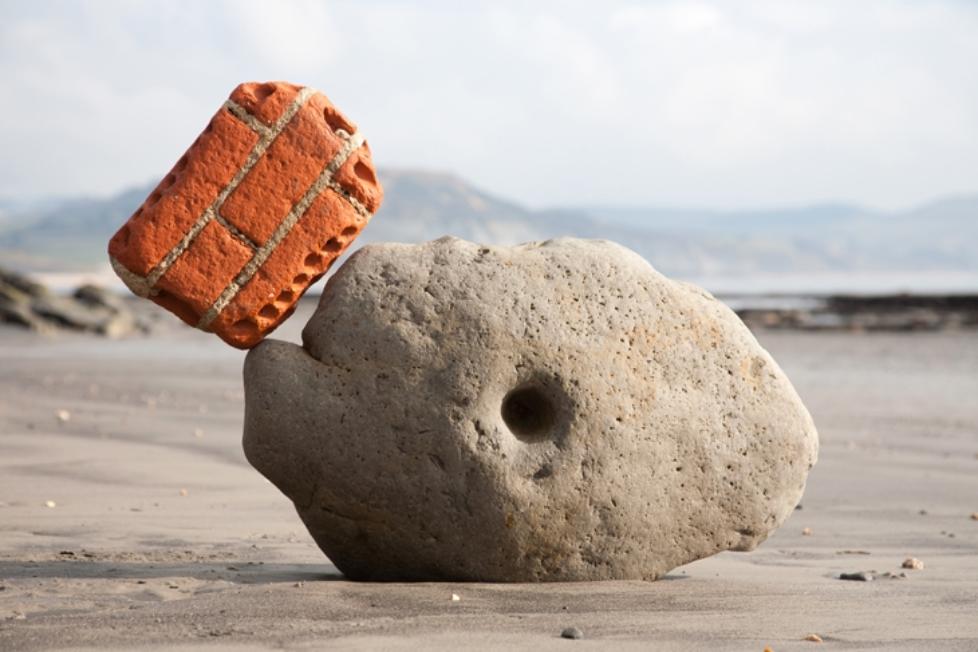If you scoop clay from the ground, pat it into shape and bake it in a kiln, you have yourself a brick. Fired earth. (Often adding an ingredient or two, but sometimes just local clay).
Man has been doing this for at least 6000 years. Digging clay, shaping it into rectangular blocks and using them to build mostly rectangular buildings. Bricks with straight edges and square corners, mostly assembled into buildings with straight edges and square corners.
Despite working initially in architecture, and later in the restoration and preservation of buildings, I take a perverse delight in seeing Mother Nature taking hold of abandoned buildings and roughing up the edges. Buddleia, ivy and ash, once they get into mortar joints, are adept at prising brickwork apart in neglected buildings. Bricks that fall into rivers and seas get broken and tumbled until they take on a more natural pebble shape. The parts that are ground away end up as grains among the sand or silt. When combing beaches and riverbanks I quite often pick up egg-shaped pieces of what used to be bricks.
In the past I have tried my hand at carving stone, and wood. I still do so now and then. But I like the discipline of working with these single-size blocks of already-fired clay - especially when rescued from the crusher and given a new future. For anyone tempted to try the same, please be aware that the ceramic dust generated when cutting or grinding bricks is dangerous to eyes and lungs.
For information on the history of bricks, see http://en.wikipedia.org/wiki/Brick
See also this excellent site http://www.brocross.com/Bricks/Penmorfa/index.htm showing more than 5000 different old bricks that feature the makers' names on them. Plus links to a vast array of brick information. (with thanks to Dave Sallery and Dave Kitching) ((Please copy-and-paste url if link not clicking through at present - I will try and fix that function)
For local brick history, see 'Herefordshire Bricks & Brickmakers' by Edwin Davey & Rebecca Roseff.
See also https://www.scottishbrickhistory.co.uk/
At Facebook there's an interesting page called Brick Of The Day
Brick sizes varied from place to place, but were generally of a size that comfortably fitted the hands of bricklayers. In 1784, during the reign of George 111, one of the taxes introduced in Britain to help pay for wars in the American colonies, was a brick tax. Initially 4 shillings per thousand bricks, three increases took it to 5s 10d by 1805. To mitigate the effect, brickmakers increased the size of bricks, in response to which a size limit was imposed. In some areas, builders and architects turned away from using brick. Many small makers, unable to quickly amend production, and burdened with tax arrears, went out of business. The tax was abolished in 1850, by when it was deemed to have become detrimental to business.
Wearing my Architectural Technician hat I can fully appreciate the advantages of the standardised metric brick, conforming so conveniently to a modular format. And there are some beautiful ones. But the bigger older bricks are 'real ale'. I smile when I see them.
Many of the items I make will last long enough to be passed down from generation to generation, or may be permanently embedded within paving - so I hope to come up with a few designs worthy of permanent display.
The image below is from the website of stone balancing artist Adrian Gray, who I watched at work on the seashore at Lyme Regis. He balances rocks - and in this example a seawashed chunk of brickwork - using nothing but gravity and great patience. No wires, pins, adhesives or trickery. What he does looks impossible. Watching him is both soothing and disturbing at the same time. His website is www.stonebalancing.com
